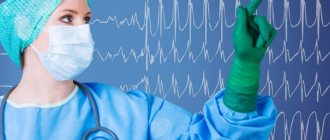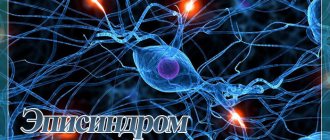Rules of first aid for an epileptic attack
An attack of epilepsy is not as terrible and dangerous as failure to provide assistance to the patient at this moment.
It is necessary to remove sharp, heavy objects and those that are dangerous for the patient and others. It is advisable to find something soft (pillow, blanket, towel, folded clothes) to place under the patient’s head. Do not hold the patient by force - this will worsen the condition. You need to note for yourself the time the attack began; if it lasts more than 5 minutes, you need to call a medical ambulance. There is no need to unclench your jaws so as not to injure your tongue, teeth and oral mucosa due to muscle hypertonicity. It is necessary to fix the victim’s head between the legs, place clothes, a blanket, a pillow under it, or roll up the clothes. Tight clothing needs to be loosened. If there is excessive salivation, then the head must be turned to the side. The patient may experience spontaneous urination.
Causes and pathogenetic mechanisms of disease development
Paroxysm occurs against the background of highly synchronous potentials (a kind of “electrical discharges”) generated by the epileptic focus, which spread along neurons and nerve fibers. Outwardly, this is expressed by uncontrollable muscle spasms, disorders of consciousness, speech, and thinking.
The etiology of the disease has not been fully elucidated. Most experts are convinced that hereditary predisposition plays a major role. Thus, almost 40% of patients with epileptic disorders had parents who also suffered from a similar illness.
In addition, mild epilepsy can be caused by:
- hypoxia, asphyxia, trauma during childbirth;
- intrauterine lesions of the central nervous system due to fetal intoxication, placental insufficiency, genetic defects and the influence of other pathological factors;
- traumatic brain injuries;
- stroke;
- neuroinfections, complications after bacterial and viral diseases;
- neoplasms, brain surgery.
In some cases, despite a comprehensive examination of the patient, it is not possible to establish the exact cause of the pathology.
What should you not do during an attack?
There is no need to restrain a person by force, try to bring him to his senses, hit him in the face, or bother him.
This will lead to greater trauma for the patient. If your teeth are clenched, there is no need to force your jaw open. Muscles are hypertonic and such actions can injure teeth, tongue and block the airways with tooth fragments. You cannot move or transfer a person to another place; such measures are necessary if the attack began in a place that threatens life. Immediately after its completion, there is no need to give the victim water or medications, because muscle function has not yet been restored and the patient may choke. You can't do chest compressions or artificial ventilation.
What to do after an epileptic attack?
After an epileptic seizure, the victim experiences weakness, lethargy, and confusion. Often he does not remember what happened to him, so your task is to calm him down and explain what happened.
In some cases, a person may ask you to help them take medications that they have with them. It is strictly prohibited to administer any medications to the victim yourself.
Ask the person if they have had epileptic seizures before. If this happens for the first time, call an ambulance. Otherwise, discuss the need for this step with the victim.
Quite often after an attack a person immediately falls asleep. Don't wake him up as he needs to rest. Stay close until he wakes up.
First aid for an epileptic attack in adults and children differs in that the child should definitely call an ambulance.
Situations in which you should call an ambulance:
- an epileptic attack occurred in a person for the first time;
- the duration of the attack was more than 5 minutes;
- after a seizure, a person remains unconscious for more than 10 minutes;
- an epileptic seizure occurred in a child or an elderly person;
- the attack occurred in a pregnant woman;
- During a seizure, a person was injured.
Manifestations of a grand mal seizure
An attack with loss of consciousness, severe convulsions of the body and limbs is a grand mal seizure.
Its symptoms:
- before this, the patient feels an unusual smell or hears a sound;
- pulse may be normal;
- sudden loss of consciousness, convulsive movements of the body, head, arms and legs;
- the tongue may be bitten, blue in color, pupils do not react to light;
- foam may be released from the mouth;
- respiratory arrest may occur, but quickly recovers;
- duration – from 20 seconds to several minutes.
How to prevent an epilepsy attack?
Most people with epilepsy experience an aura, a sensation or experience that regularly precedes an attack. The nature of the aura depends on the area of the brain in which the seizure focus is localized.
Thus, the aura can be expressed in an increase in temperature, a strange sound, smell or taste, a feeling of anxiety, impaired visual perception, dizziness, discomfort in the abdomen, a state of déjà vu (previously seen) or jamevu (unseen before), etc.
A person’s knowledge of his aura is important not only in diagnosing changes in the functional activity of the brain, but also in many cases helps prevent the development of an attack. For example, if an attack begins under conditions of sadness or melancholy, to prevent the attack you should avoid any sad or melancholy thoughts.
In the case where an olfactory aura is present (the feeling of an unusual odor before an attack), it can be interrupted by inhaling a stronger and more pronounced odor, for example, the smell of ammonia.
If the onset of an attack is preceded by an involuntary movement of a limb, the attack can be suppressed by making the opposite movement. For example, if clenching your palm into a fist is a harbinger of an attack, straightening your palm or keeping it calm can avoid it.
Causes of occurrence and development
The appearance of a convulsive attack can be due to a number of reasons:
- brain tumor, meningitis, stroke;
- alcohol in high doses, drugs;
- poisoning with chemicals, poisons, paints and varnishes;
- diseases of the liver and kidneys that impair the functioning of these organs.
The occurrence of idiopathic epilepsy is associated with heredity, does not cause changes in the psyche, and most often manifests itself before the age of 25. This form of epilepsy is easily corrected with therapy.
Epilepsy
Encephalitis
4904 08 July
IMPORTANT!
The information in this section cannot be used for self-diagnosis and self-treatment.
In case of pain or other exacerbation of the disease, diagnostic tests should be prescribed only by the attending physician. To make a diagnosis and properly prescribe treatment, you should contact your doctor. Epilepsy: causes, symptoms, diagnosis and treatment methods.
Definition
Epilepsy is a chronic brain disease with a high level of disability, characterized by recurrent seizures that arise as a result of excessive neural discharges and are accompanied by a variety of disorders of motor, sensory, autonomic, mental and mental functions.
Causes of epilepsy
The term “epilepsy” comes from ancient Greek. ἐπίληπτος - seized, caught, caught. In Russia, epilepsy was usually called “falling disease” and was regarded as “God’s punishment.”
Epilepsy is characterized by repeated seizures, as well as the gradual development of personality changes characteristic of the disease and/or characteristic epileptic dementia.
The main causes of epilepsy are individual predisposition and the presence of epileptic damage with local or generalized electrical changes in the brain. Neural activity in the brain becomes abnormal, periodic, and excessive as epilepsy develops. Sudden high-voltage bursts occur in a group of neurons. Epileptic neurons form an epileptic focus that generates a hypersynchronous discharge. If this discharge spreads throughout the brain, a generalized seizure occurs. If the discharge does not spread, the seizure is partial (local) in nature.
Epileptic seizures often occur with hereditary diseases of the nervous system (lipidoses, tuberous sclerosis, leukodystrophy, etc.). Possible brain damage during pregnancy (fetal hypoxia, maternal infection, the effects of alcohol and psychotropic substances on the body of the mother and fetus) and during childbirth (excessive changes in the shape of the head as it passes through the birth canal). Numerous toxins, medications, changes in blood electrolytes in chronic kidney and liver diseases, and brain tumors can increase neuronal activity. In children, epileptic seizures often occur in the early stages of meningitis and encephalitis. Severe traumatic brain injury can also be complicated by epilepsy.
Epilepsy is often observed in multiple sclerosis and Alzheimer's disease.
Thus, epilepsy can be caused (provoked) by many factors:
- hereditary;
- congenital (effects on the fetus during pregnancy and childbirth);
- acquired (resulting from previous brain diseases with the formation of an epileptic focus).
Classification of epilepsy
- Idiopathic epilepsy.
- Symptomatic epilepsy:
- for acute cerebrovascular accidents;
- meningitis;
- encephalitis;
- brain tumors;
- endogenous intoxications (damage to the kidneys, liver, adrenal glands, uremia, eclampsia);
- exogenous intoxications (as a result of chronic alcoholism, taking barbiturates, exposure to carbon dioxide, benzene, mercury).
Classification of epileptic seizures I. Partial (focal, local) seizures
(seizures involve individual muscle groups).
- Simple partial seizures (consciousness is not impaired):
- with motor symptoms;
- with somatosensory or specific somatosensory symptoms;
- with vegetative symptoms;
- with mental symptoms.
- Complex partial seizures (with impaired consciousness):
- starting as simple partial seizures and progressing to loss of consciousness;
- without other manifestations;
- with manifestations as in simple partial seizures;
- with automatisms.
- With disturbances of consciousness at the beginning of an attack:
- without other manifestations;
- manifesting as a simple partial attack;
- with automatisms.
- Partial seizure with secondary generalization:
- simple partial seizure followed by generalization;
- complex partial seizure with subsequent generalization;
- a simple partial seizure, developing into a complex partial seizure with subsequent generalization.
II. Generalized seizures (convulsive and non-convulsive)
.
- Absence seizures:
- typical absence seizures;
- atypical absence seizures.
- Myoclonic seizures.
- Clonic seizures.
- Tonic seizures.
- Tonic-clonic seizures.
- Atonic attacks (astatic).
III.
Unclassified epileptic seizures (includes some neonatal seizures such as rhythmic eye movements, chewing, swimming movements).
Symptoms of epilepsy
Partial seizures
can occur at any age and are characterized by contraction of individual muscle groups - the person makes small movements with the hands, slurps, the patient can reproduce inarticulate sounds. There is a disturbance in the sensitivity of certain areas of the body.
With simple partial seizures, consciousness is most often preserved, with complex ones it is impaired.
The patient loses contact with reality for 1-2 minutes, does not understand speech addressed to him and sometimes actively resists the assistance provided. After the seizure is over, the patient does not remember anything about it.
Partial seizures may have motor manifestations
when convulsions occur in a strictly defined part of the body (thumb, face), lasting several hours. Cramps may appear focally and then spread to other parts of the body (finger - wrist - forearm). Seizures can be in the form of involuntary turns of the head and torso or short-term speech delay.
Partial seizures with autonomic disturbances
characterized by sudden palpitations, sweating, and a feeling of fear.
Seizures with sensory disturbances
manifested by tingling in a strictly defined area, visual (flash of light) or auditory sensations, sudden dizziness, etc.
Seizures with mental manifestations
characterized by an unexpected loss of the ability to understand speech or speak, the appearance of an obsessive thought, a feeling of close familiarity with a place or situation, and hallucinations.
For partial complex seizures
a certain degree of change in consciousness is characteristic at the onset or during the seizure. The patient may be aware of the seizure, as if something unusual is happening, but evaluates what is happening as a dream.
Altered consciousness may be the only symptom of complex partial seizures or an addition to their other manifestations (time distortion, memory impairment, the appearance of a single dominant thought, hallucinations, feelings of fear, etc.).
Seizures are considered generalized
, the development of which indicates the involvement of both hemispheres of the brain in the process, in the vast majority of cases they are characterized by loss of consciousness. They may begin with an aura (involuntary head movements, visual, auditory and olfactory hallucinations). Then the patient screams, loses consciousness and falls, convulsions occur, during which he can bite his tongue, foamy discharge appears from the mouth, and involuntary urination appears. After the seizure, the patient does not remember the seizure, but he is bothered by headache and muscle pain.
Generalized seizures include tonic-clonic, tonic, clonic, myoclonic, atonic and absence seizures.
Tonic cramps are sudden and prolonged muscle contractions in which a limb or the entire body freezes in a forced position.
Clonic seizures are irregular short-term spasms characterized by rapid alternation of periods of contraction and relaxation of skeletal muscles.
Atonic seizures
is a loss of consciousness with a sudden loss of muscle tone and an equally rapid recovery. The decrease in muscle tone can be fragmented, limited to a specific segment (limb, jaw, head) or massive, which leads to falls, without preceding myoclonic or tonic components.
Generalized tonic-clonic seizures are characterized by a change in tonic tension of all muscle groups (tonic phase) and intermittent muscle contractions (clonic phase) against the background of a complete loss of consciousness.
Generalized myoclonic seizures are diffuse rapid asynchronous muscle twitches caused by involuntary contraction of individual muscle bundles. They may not affect all muscles of the body, but are always symmetrical in nature.
Simple absence seizure
- this is an involuntary, short-term (up to 15–20 s), sudden switching off of consciousness that does not depend on the will of the patient, which periodically repeats in a stereotypical manner. Apart from loss of consciousness, there are no other visible manifestations and disorders with simple absence seizure. When recovering from an attack, there is no malaise or stupor, and during an attack, patients can continue to perform the actions started before it (play, write, read).
During a complex absence seizure
switching off consciousness is accompanied by accompanying visible clinical symptoms (shuddering of the whole body or myoclonic twitching of individual muscle groups; immobility; flexion and extension, rotational movements, etc.).
Status epilepticus occurs spontaneously, convulsive seizures follow each other and last about 30 minutes. Clinically, four types of status epilepticus are distinguished:
- regularly recurring seizures with tonic and clonic phases and complete loss of consciousness;
- regularly repeating isolated contractions of individual muscle groups, only tonic or only clonic convulsions and complete loss of consciousness;
- isolated continuous cramps of a certain muscle group, which can occur without turning off consciousness;
- regularly recurring seizures without muscle activity, but with complete loss of consciousness.
The epileptic process affects the mental status of the patient - the earlier the disease begins, the more pronounced the mental disorders.
Epileptics are often obsessive, pedantic, extremely self-centered, and slow. Diagnosis of epilepsy
The diagnosis is established by a combination of complaints characteristic of epilepsy, information received from the patient about the course of the disease, data from laboratory and instrumental examination methods.
For patients with suspected epilepsy, the following questions are asked:
- duration of the disease;
- the presence of epilepsy in close relatives;
- previous cases of seeking medical help for seizures and the presence of previous studies and conclusions;
- comorbidities to assess additional risks;
- medications taken at the time of contacting the doctor.
For patients with epilepsy, the doctor may prescribe a set of laboratory and instrumental diagnostic methods:
- clinical blood test with determination of hemoglobin concentration, number of erythrocytes, leukocytes and platelets, hematocrit and erythrocyte indices (MCV, RDW, MCH, MCHC), leukoformula and ESR (with microscopy of a blood smear in the presence of pathological changes);
How to spot an impending seizure
The seizure usually occurs suddenly. A person who suffers from epilepsy usually cannot accurately predict the time of an attack and the situation in which it will occur. Often, patients with epilepsy experience tension, fear that an attack will happen and that this will cause a negative reaction from others. A number of people note that they observe an aura before the onset of seizures. This may be a state of euphoria, unusual smells, sounds, a sense of taste, or a feeling that such a situation has already happened (déjà vu).
SIGNS OF AN EPILEPTIC ATTACK
The first symptom of an epileptic attack may be an aura. Sometimes it is easy for the patient to recognize it by characteristic feelings, thoughts, and behavior. An aura is characterized by the appearance of unusual smells, sounds or tastes, blurred vision, fear, panic, negative or very pleasant feelings, chaotic thoughts, headache and dizziness, nausea, numbness or tingling in different parts of the body.
Mid-epileptic seizure. Visible symptoms include fainting, memory loss, confusion, inability to distinguish or hear sounds, loss of vision or visual hallucinations, speech disturbances, drooling, frequent blinking, lack of movement or muscle tone, tremors, jerking of the limbs or the whole body, automatisms ( repetitive movements), convulsions, urinary or fecal incontinence, changes in skin color (pallor, cyanosis), difficulty breathing, rapid pulse and falling from height. The last feature of epilepsy is associated with the Russian name for the disease - “falling disease”.
After an epileptic seizure, some people recover immediately. Others require several minutes or even hours. At this time, they may experience drowsiness, memory impairment, weakness, slow reactions, speech impairment, dizziness, headache, nausea, thirst, and upset stomach.
Treatment
Epilepsy is treated with medication.
The doctor prescribes anticonvulsants; they suppress the occurrence of pathological impulses in the brain. Additionally, psychotropic drugs (hypnotics, antidepressants, tranquilizers) are prescribed. Psychotropic medications should be taken without violating the doses prescribed by the doctor. Because they may be triggers for attacks or side effects. Therapy is not always lifelong. The doctor monitors the patient and if there is noticeable improvement and there are no recurrent attacks, then therapy can be adjusted, even to the point of discontinuation.
Where is epilepsy treated in Moscow?
The disease in Moscow is treated in medical centers specializing in the treatment of epilepsy. The neurology clinic diagnoses and treats epilepsy and various neurological diseases, including Alzheimer's disease, dementia, and Parkinson's disease. The neurological department provides treatment after head trauma and stroke. The hospital treats epilepsy in children and adults; the disease is diagnosed in the hospital's diagnostic center. You can make an appointment with a doctor by calling the Yusupov Hospital.









